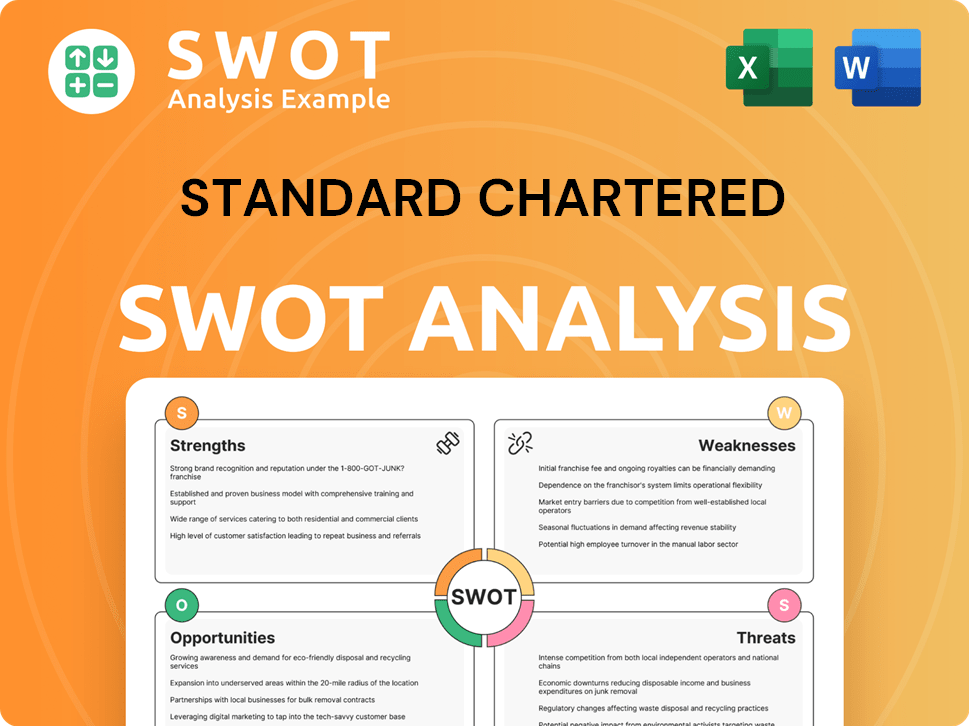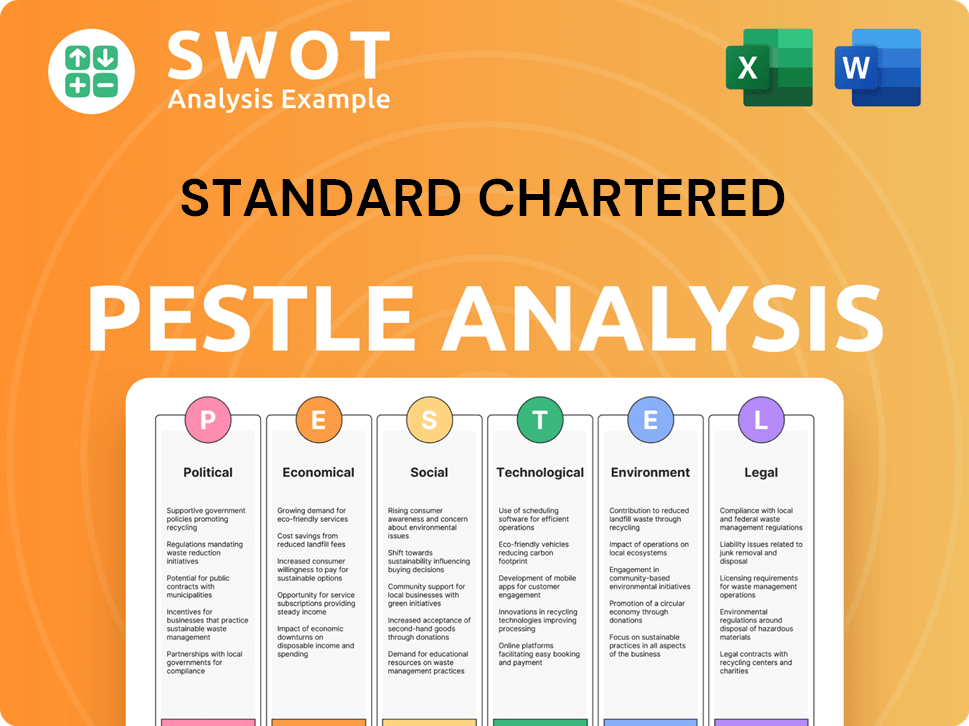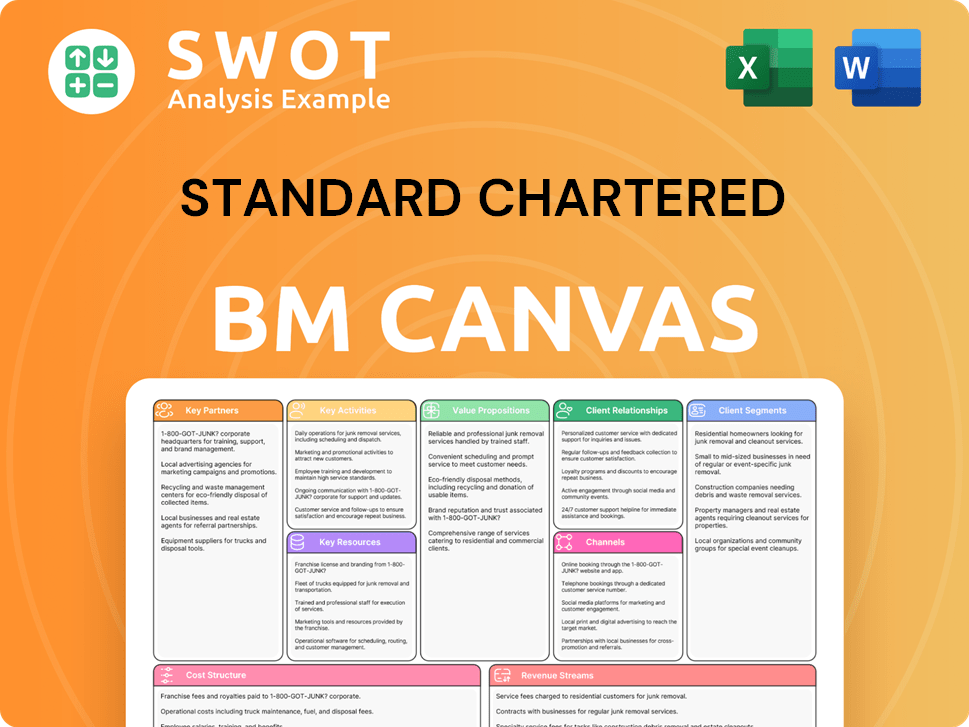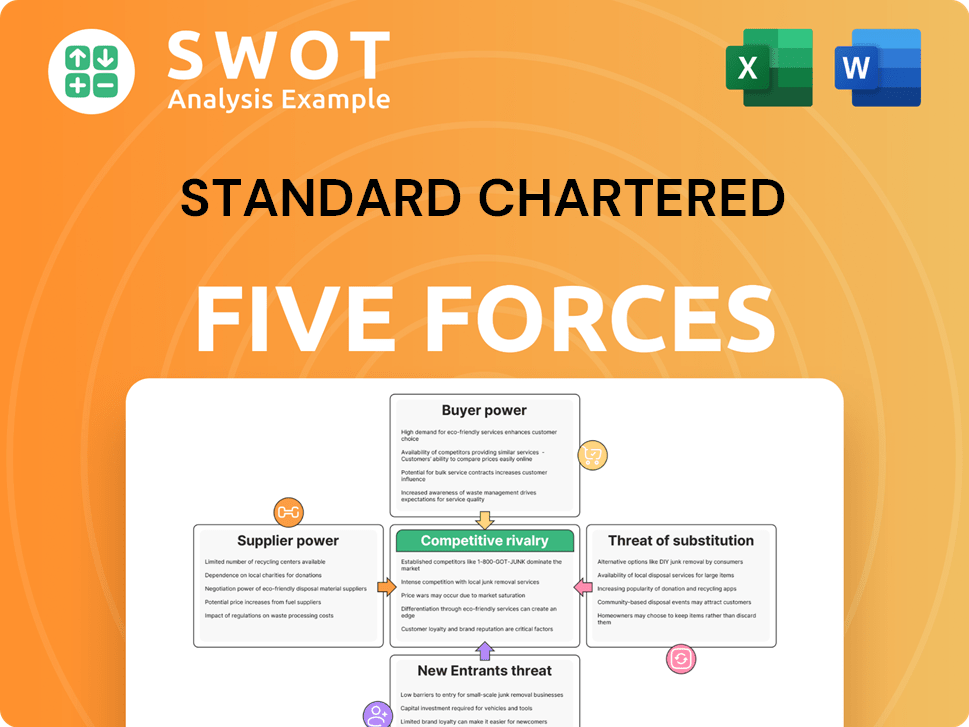Standard Chartered Bundle
What Drives Standard Chartered's Global Strategy?
Delving into the core of Standard Chartered's operations reveals more than just banking; it uncovers a carefully crafted mission, vision, and set of core values. These foundational elements are the compass guiding their strategic direction and defining their aspirations in the global financial arena.

Understanding the Standard Chartered SWOT Analysis is crucial, but equally important is grasping the essence of the Standard Chartered mission, vision, and core values. These principles shape the bank's interactions with clients, product development, and its contributions to the communities it serves. Exploring these elements provides key insights into Standard Chartered's goals and its approach to achieving sustained success.
Key Takeaways
- Standard Chartered's mission, vision, and values are central to its strategy and recent success.
- The bank's focus on emerging markets and commitment to sustainability are key strengths.
- Strong 2024 financial performance highlights the effectiveness of its guiding principles.
- Continued adherence to values is vital for navigating future challenges and opportunities.
- Standard Chartered's diversity-driven approach positions it for continued impact in global markets.
Mission: What is Standard Chartered Mission Statement?
Standard Chartered's mission is "to drive commerce and prosperity through our unique diversity, encapsulated in the brand promise, 'Here for good.'"
Let's delve into the core of Standard Chartered's purpose. This mission statement is more than just words; it's a declaration of intent, guiding the bank's actions and shaping its impact on the world.
The first part of the Standard Chartered Mission focuses on facilitating economic activity. This means enabling trade, investment, and financial flows to foster growth. Their goal is to contribute to the financial well-being of individuals and businesses.
Standard Chartered leverages its extensive network across Asia, Africa, and the Middle East. This geographical diversity is a key differentiator, allowing them to connect clients to opportunities in high-growth markets. This is a core aspect of the Standard Chartered Company.
This promise signifies a commitment to long-term positive impact. It goes beyond simply providing financial services; it encompasses social and environmental responsibility. This commitment is a key element of SCB Values.
Standard Chartered actively supports sustainable development through its financing activities. For instance, they aim to provide USD 3 billion in financing to microfinance institutions by December 2024. They also aim to mobilize USD 300 billion in sustainable finance by December 2030, demonstrating their commitment to sustainability. This is a crucial part of the Standard Chartered Goals.
A significant aspect of their mission involves connecting corporate, institutional, and affluent clients to growth opportunities within their network. This helps drive commerce and supports their clients' financial objectives. Understanding this is key to grasping the Standard Chartered Mission.
The mission is strongly geared towards making a positive societal and economic impact, leveraging their diverse global presence. This focus on both financial performance and positive impact sets them apart. To understand their position in the market, explore the competitive landscape.
In essence, the Standard Chartered Mission is a comprehensive statement that underscores the bank's commitment to driving economic growth, fostering prosperity, and making a positive impact on society, all while leveraging its unique global footprint and brand promise.
Standard Chartered SWOT Analysis
- Complete SWOT Breakdown
- Fully Customizable
- Editable in Excel & Word
- Professional Formatting
- Investor-Ready Format

Vision: What is Standard Chartered Vision Statement?
Standard Chartered's vision is articulated as 'To be the world's leading international bank, providing customers with a seamless banking experience that transcends borders and cultures.'
Let's delve into the details of what this vision entails for Standard Chartered Company.
The primary aim of the Standard Chartered Vision is to achieve leadership within the international banking sector. This leadership extends beyond mere financial metrics; it encompasses setting standards for service, innovation, and global reach.
A crucial element of the Standard Chartered Vision is to provide a seamless banking experience. This means ensuring that customers can conduct transactions, access services, and manage their finances without encountering geographical or cultural barriers.
The vision explicitly emphasizes transcending borders and cultures. This highlights Standard Chartered's commitment to understanding and serving diverse markets. This is a key aspect of the SCB Values.
Another articulation of their vision is 'To be the right partner for our customers, employees, and communities.' This signifies a commitment to building strong, mutually beneficial relationships with all stakeholders. This is a core tenet of Standard Chartered Goals.
The vision is ambitious, but it's grounded in the company's current trajectory. With a record income of $19.7 billion in 2024 and a return on tangible equity of 11.7%, Standard Chartered demonstrates a strong financial foundation to support its aspirations. For more insights into the company's strategic direction, consider reading about the Growth Strategy of Standard Chartered.
Their strategic focus on emerging markets, digital innovation, and sustainability further supports the realism of their aspirations. These initiatives are crucial for achieving the Standard Chartered Mission and long-term vision.
The Standard Chartered Company's vision is a comprehensive statement that guides its strategic direction and operational activities. It reflects a commitment to global leadership, customer-centricity, and sustainable growth. Understanding this vision is key to grasping the Core Values of Standard Chartered Bank and its overall strategic objectives.
Standard Chartered PESTLE Analysis
- Covers All 6 PESTLE Categories
- No Research Needed – Save Hours of Work
- Built by Experts, Trusted by Consultants
- Instant Download, Ready to Use
- 100% Editable, Fully Customizable

Values: What is Standard Chartered Core Values Statement?
Standard Chartered's core values are the bedrock of its operations, shaping its culture and guiding its interactions with stakeholders. These values are crucial for understanding the company's approach to business and its commitment to its mission and vision.
Integrity is paramount at Standard Chartered, emphasizing ethical conduct and transparency in all dealings. This commitment is reflected in their adherence to stringent regulatory standards and efforts to build trust with clients, partners, and the wider community. This is evident in their reported compliance metrics and risk management strategies, ensuring responsible financial practices.
Standard Chartered strives for excellence by delivering high-quality products and services that meet and exceed customer expectations. This is demonstrated through continuous improvement initiatives and adaptation to the evolving financial landscape, including investments in digital banking and innovative financial solutions. Their commitment to excellence is reflected in their customer satisfaction scores and industry awards.
Collaboration is a cornerstone of Standard Chartered's culture, fostering a supportive environment where employees share knowledge and capabilities. This collaborative spirit is essential for driving innovation, problem-solving, and achieving the company's strategic goals. The bank's emphasis on teamwork is reflected in its internal communication strategies and cross-functional project initiatives.
Standard Chartered actively promotes diversity and inclusion within its workforce and the communities it serves. This commitment is seen as a source of competitive advantage, driving innovation and business growth by leveraging a wide range of perspectives and experiences. Initiatives include targeted recruitment programs and employee resource groups, contributing to a more inclusive workplace.
These SCB Values collectively define Standard Chartered's unique identity, emphasizing responsible banking, ethical behavior, and a dedication to the communities it serves. Understanding these core values is vital to grasping how the company operates and achieves its objectives. To further understand the financial aspects of Standard Chartered, you can explore Revenue Streams & Business Model of Standard Chartered. Next, we will explore how the Standard Chartered mission and Standard Chartered vision influence the company's strategic decisions.
How Mission & Vision Influence Standard Chartered Business?
Standard Chartered's Standard Chartered mission and Standard Chartered vision are not merely aspirational statements; they are the cornerstones upon which the company builds its strategic decisions. These statements directly shape the bank's focus, investments, and overall direction, ensuring that every action aligns with its core purpose.
The influence of Standard Chartered's mission and vision is most evident in its strategic initiatives. These initiatives are carefully designed to deliver on the bank's purpose of driving commerce and prosperity, particularly within its key markets.
- Focus on Emerging Markets: Standard Chartered's commitment to emerging markets is a direct reflection of its mission to drive commerce and prosperity.
- Sustainable Finance: The bank's emphasis on sustainable finance aligns with its mission and its value of sustainability.
- Digital Transformation: Investments in technology and digital capabilities support the vision of providing a seamless banking experience.
- Customer-Centric Approach: Initiatives like the investment in the affluent client segment reflect the vision of being the 'right partner' for customers.
Standard Chartered is investing heavily in its affluent client segment. This commitment involves a USD 1.5 billion investment, with the goal of attracting USD 200 billion in net new money over a five-year period. This strategic move directly supports their vision of being the 'right partner' for their customers and driving prosperity by providing tailored financial solutions.
A key aspect of Standard Chartered's strategic direction is its commitment to sustainable finance. The bank aims to mobilize USD 300 billion in sustainable finance by December 2030. This target reflects their mission to drive commerce and prosperity while upholding their SCB Values, particularly sustainability. The bank's sustainable finance income reached $982 million in 2024, approaching their 2025 target of $1 billion, showing significant progress.
Standard Chartered is investing approximately $1 billion in technology and digital capabilities. This investment is driven by their vision of providing a seamless banking experience and their value of excellence. A key objective is a 30% reduction in transactional banking costs by 2025. This digital transformation is crucial for enhancing efficiency and customer service.
The Standard Chartered Company strategically expands its presence in key markets such as Asia, Africa, and the Middle East. This expansion is a direct result of the bank's mission and vision, focusing on driving commerce and prosperity in these regions. Product development is also guided by these principles, ensuring offerings meet the needs of these diverse markets.
Group Chief Executive Bill Winters has emphasized that the clarity of the refined strategy, which is driven by the Standard Chartered mission, has energized employees. This clarity leads to a more comprehensive understanding and appreciation of Standard Chartered externally. This alignment ensures that all employees are working towards the same goals.
Standard Chartered's strategic decisions are also shaped by industry challenges, such as the growing need for sustainable finance. The bank's commitment to sustainable finance and its digital transformation efforts demonstrate its adaptability and forward-thinking approach. This is part of their commitment to their Standard Chartered Goals.
The strategic decisions made by Standard Chartered, influenced by its Standard Chartered Core Values, are designed to ensure the bank’s long-term success and its ability to serve its stakeholders effectively. For more insights into the ownership structure that supports these strategic decisions, you can read about the Owners & Shareholders of Standard Chartered. Next, we will explore the core improvements to the company's mission and vision.
Standard Chartered Business Model Canvas
- Complete 9-Block Business Model Canvas
- Effortlessly Communicate Your Business Strategy
- Investor-Ready BMC Format
- 100% Editable and Customizable
- Clear and Structured Layout

What Are Mission & Vision Improvements?
While Standard Chartered's foundational statements are robust, continuous improvement is vital in today's dynamic financial landscape. This section explores potential enhancements to their mission, vision, and values to further solidify their position and future-proof their strategy, considering the ever-evolving demands of the market and the increasing importance of digital transformation and sustainability.
To enhance their vision, Standard Chartered could explicitly integrate digital transformation. This would highlight their commitment to leveraging technology for superior customer experiences and operational efficiency. This is crucial, as digital banking adoption continues to surge, with mobile banking users projected to reach 2.1 billion by 2027, according to Statista.
Standard Chartered's vision could be strengthened by acknowledging the potential of decentralized finance (DeFi) and other disruptive technologies. Framing these as opportunities within their vision demonstrates adaptability and a forward-thinking approach to the future of banking. The DeFi market, though volatile, shows significant growth potential, with total value locked (TVL) in DeFi protocols reaching over $40 billion in early 2024.
While sustainability is a core value, further articulating the mission and vision's direct contribution to a just transition to net zero and addressing climate change could enhance resonance with stakeholders. This could include specific targets and initiatives, reflecting the growing importance of Environmental, Social, and Governance (ESG) factors. According to a 2024 report by the World Economic Forum, sustainable finance is crucial for achieving global climate goals, with trillions of dollars needed in green investments.
Comparing with industry best practices, some competitor statements might be more concise or utilize more evocative language. Reviewing the language used in the Standard Chartered mission, Standard Chartered vision, and Standard Chartered Core Values could help ensure they are as impactful as possible. For more on how to refine your strategic approach, consider exploring the Marketing Strategy of Standard Chartered.
How Does Standard Chartered Implement Corporate Strategy?
The successful integration of a company's mission, vision, and core values is crucial for its long-term strategy and operational success. This implementation phase translates aspirational statements into tangible actions, fostering a culture of purpose and guiding decision-making across all levels of the organization.
Standard Chartered Company demonstrates the practical application of its guiding principles through various strategic initiatives. These initiatives are carefully designed to reflect the company's mission, vision, and core values in its day-to-day operations and long-term goals. This commitment is evident in its approach to sustainable finance and employee empowerment.
- Sustainable Finance: Standard Chartered actively integrates Environmental, Social, and Governance (ESG) factors into its financial frameworks. A prime example is the Sustainable Account with Liquidity Management Structure, designed for clients. This initiative directly supports their mission to drive prosperity and their value of sustainability. The bank aims to mobilize $300 billion in sustainable finance by 2030.
- Employee Empowerment: The company invests heavily in employee training and development programs. Standard Chartered has allocated USD 200 million to empower 90% of its employees by 2025. This reflects their commitment to their people and the value of inclusivity.
- Healthier Workplaces: Standard Chartered's adoption of the WELL Building Standard globally demonstrates a commitment to employee well-being, aligning with their people-centric approach.
Leadership plays a critical role in reinforcing the Standard Chartered mission, vision, and core values. Leaders are expected to embody and promote the desired behaviors, ensuring that the values are not just stated but actively practiced throughout the organization. This commitment from the top helps to cascade the values down, creating a cohesive and purpose-driven culture.
Standard Chartered Company effectively communicates its mission, vision, and values through multiple channels. These channels ensure that all stakeholders, including employees, investors, and customers, are well-informed about the company's core principles and strategic direction. Transparency in communication reinforces the values and builds trust.
- Annual Reports and Investor Presentations: These publications provide detailed insights into the company's performance and strategic direction, highlighting how the mission, vision, and values guide decision-making.
- Internal Communications: Regular updates, newsletters, and town hall meetings keep employees informed and engaged with the company's values and goals.
To ensure that the stated values translate into actual business practices, Standard Chartered has implemented formal programs and systems. These mechanisms help to measure and align employee behavior with the company's core values. This commitment helps to create a consistent and ethical work environment.
- Standard Chartered Valued Behaviours Assessment: This program evaluates employees' adherence to the company's core values, ensuring that actions align with the stated principles.
- Performance Management Systems: These systems incorporate the company's values into performance evaluations, reinforcing the importance of ethical behavior and adherence to the guiding principles.
The consistent application of the Standard Chartered mission, vision, and core values significantly impacts both employees and customers. For employees, it fosters a sense of purpose and belonging, leading to higher engagement and productivity. For customers, it builds trust and confidence in the company's commitment to ethical and sustainable practices. Understanding the target market of Standard Chartered provides further insight into how these values are tailored to meet customer needs.
Standard Chartered Porter's Five Forces Analysis
- Covers All 5 Competitive Forces in Detail
- Structured for Consultants, Students, and Founders
- 100% Editable in Microsoft Word & Excel
- Instant Digital Download – Use Immediately
- Compatible with Mac & PC – Fully Unlocked

Related Blogs
- What are Mission Vision & Core Values of Standard Chartered Company?
- What is Competitive Landscape of Standard Chartered Company?
- What is Growth Strategy and Future Prospects of Standard Chartered Company?
- How Does Standard Chartered Company Work?
- What is Sales and Marketing Strategy of Standard Chartered Company?
- Who Owns Standard Chartered Company?
- What is Customer Demographics and Target Market of Standard Chartered Company?
Disclaimer
All information, articles, and product details provided on this website are for general informational and educational purposes only. We do not claim any ownership over, nor do we intend to infringe upon, any trademarks, copyrights, logos, brand names, or other intellectual property mentioned or depicted on this site. Such intellectual property remains the property of its respective owners, and any references here are made solely for identification or informational purposes, without implying any affiliation, endorsement, or partnership.
We make no representations or warranties, express or implied, regarding the accuracy, completeness, or suitability of any content or products presented. Nothing on this website should be construed as legal, tax, investment, financial, medical, or other professional advice. In addition, no part of this site—including articles or product references—constitutes a solicitation, recommendation, endorsement, advertisement, or offer to buy or sell any securities, franchises, or other financial instruments, particularly in jurisdictions where such activity would be unlawful.
All content is of a general nature and may not address the specific circumstances of any individual or entity. It is not a substitute for professional advice or services. Any actions you take based on the information provided here are strictly at your own risk. You accept full responsibility for any decisions or outcomes arising from your use of this website and agree to release us from any liability in connection with your use of, or reliance upon, the content or products found herein.